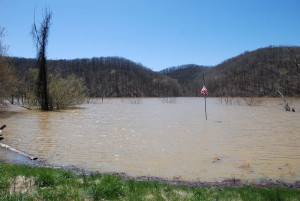By Chris Erwin
The grass is growing greener and the first buds of spring are breaking out on the trees and shrubs. The first question I get at this time every year from anglers now that the water in our lakes is making it to the 50 degree mark, is: How do I find fish?
To begin with you need to know all our lakes are not in the same shape. Some are holding high water while others are near winter pool. During this stage, it’s important to know if the lakes are falling or rising. When lakes are falling bass tends to pull back from the bank to prevent getting caught in dropping lake levels. Rising water can put fish back in trees and brush according to how much sun a particular spot may be receiving.
I have heard many anglers say that the north side of the lake will become warmer faster. I can tell you first-hand that statement is generally true. However, more must be considered.
I say this because it’s really not the only thing to consider. Lakes in our area are surrounded by hills to full-blown mountains, which tend to block out the sun shading some northern sections of lakes. In addition to how much sun an area is getting, how shallow it is and the color of the water are also important factors to consider.
Shallow stained water getting sun is going to be the warmest part of the lake. Bass and crappie will begin to stage in these areas, which should be your starting point to look for migrating fish coming from deep water. In earlier articles, I have talked about areas that are near the channel, which become shallow quickly. Of they receive sun these are a good place to start, especially if the water is stained.

Another thing to consider is what bait to throw. If the water is stained the No. 1 bait for spring has to be a jig & pig combo in dark colors. Lipless crankbaits would be my second choice if you are casting the shore line.
If you fish the water from deep to shallow, in other words, starting in deep water and working your way into shallow water, a good choice would be swimbaits or even an “A” rig. Your fish finder can help locate fish if they aren’t moving to the bank. This can be the case early in the day, but once the sun has a chance to warm the shallow-water areas fish usually start making their move.
If the water is clear, you might want to use jerkbaits, like a Rouge or Rapala. These baits jerk under the water and twitch as they are either suspended or float to the surface. The advantage to these baits is they can be fished very slowly.
When the water warms into the high 50s or low 60s, Crawfish will start to emerge. This will spark bass into being more aggressive and crankbaits (that imitate crawfish) or jigs with some kind of kicker will claim their share of strikes.
Learning quickly where to fish and what to use will greatly improve your odds. Using the topographical maps that we have discussed in other articles, along with reading the water itself and the daily water conditions will point you in the right direction.
My hard fast rule is: “Don’t keep doing the same thing and expect different results.” If you are confident in your method and it is still producing nothing, you need to change something, either the location, lure or even your presentation. It could change your outcome.
Get out there, do your best and let me know how it goes! I’m looking forward to seeing some good spring fishing pictures.



Be the first to comment